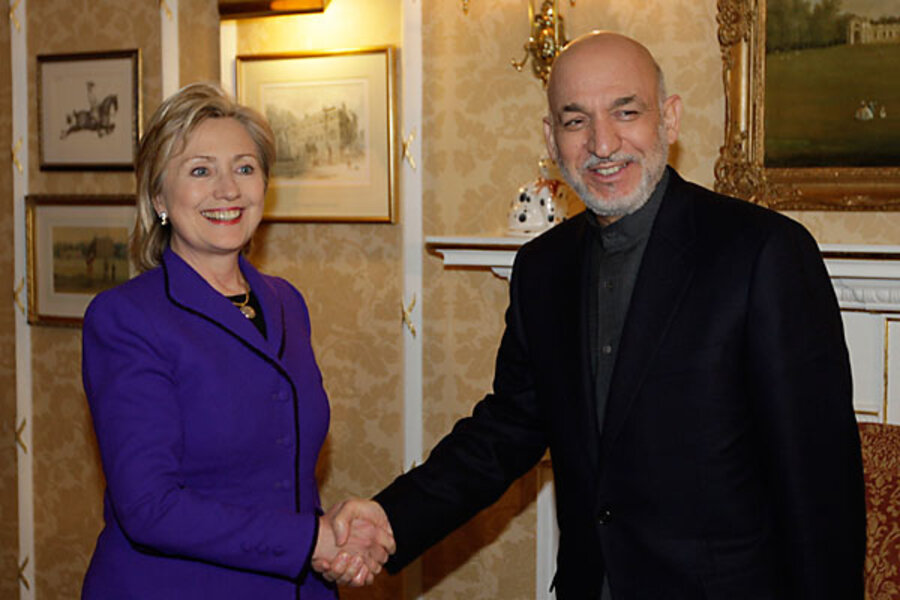Afghanistan summit: Why is the US backing talks with the Taliban?
Loading...
| Washington
Only the first few thousand “surge” forces have arrived in Afghanistan as part of the effort to tame the Taliban’s resurgence there. But the top US commander, Gen. Stanley McChrystal, is already talking about a negotiated peace with the enemy – a move that would seem counterintuitive so early in the new counterinsurgency campaign.
But McChrystal’s recent, vocal support of reconciliation and reintegration – welcoming top and low-level Taliban fighters to lay down their arms to join the Afghan political process – may be just good battlefield politics. McChyrstal, considered a sophisticated operator, is supporting President Hamid Karzai on the eve of a summit in London on Afghan security.
“As a soldier, my personal feeling is that there’s been enough fighting," said McChrystal in an interview with the Financial Times this week. "What I think we do is try to shape conditions which allow people to come to a truly equitable solution to how the Afghan people are governed.”
Also this week, the United Nations Security Council lifted sanctions against five top Taliban leaders. The move opens the door for the negotiated settlement backed by Mr. Karzai.
McChrystal’s support of this effort has been met with some surprise worldwide. Security in Afghanistan is still far from established, meaning the military is not yet in a position to dictate the terms of the reconciliation.
But there has been a shift in approach to reconciliation, say experts. The US and the international community have been more open to Karzai's attempts to bring former fighters into the political process as a way to bolster Karzai’s weak government.
“Our understanding is that Karzai is convinced that if he can protect those insurgents ..., he can turn many of them around and essentially change the dynamics of the insurgency,” says Haseeb Humayoon, a research analyst at the Institute for Study of War in Washington.
Other experts believe top officials in Washington are pushing for peace negotiations as an appealing option at a time when the American public’s support for the war is fragile at best.
A repeat of Iraq?
Moreover, all wars ultimately end with reconciliation, and the process is especially important to insurgencies. McChrystal’s push for it now may be a rhetorical carrot-or-stick admonition.
Negotiated settlements have worked before. Despite vast differences between Iraq and Afghanistan, the American military worked intensely to reconcile with former Sunni fighters in Anbar province in Iraq in 2006. That ultimately set the stage for the so-called Anbar Awakening that ended much of the hostilities.
Sunni tribes there had become disenchanted with Al Qaeda in Mesopotamia, which was killing Iraqis and stealing territory. In some cases, Al Qaeda would kill sheiks and leave their bodies in the desert, a form of disrespect to the region's thousand-year-old conventions.
Many Sunnis thought Al Qaeda, once seen as righteous warriors fighting the foreign occupation, had gone too far. That divide created the room the US needed to drive a political wedge between Sunnis and Al Qaeda.
It was at that point that the work of Lt. Gen. John Allen paid off. As a one-star general, he had spent much of his time in 2006-07 in neighboring Jordan, encouraging tribal sheiks who had fled Anbar, to return to Iraq. That encouragement led many Sunnis to flip and agree to work within the new, Shiite-led government.
Such negotiations have a bad reputation in places like Pakistan, where past Pakistani governments had repeatedly reconciled with Taliban fighters , only to see cease-fires dissolve. But those negotiations had been essentially a capitulation to the enemy to extricate the Pakistan Army from an unpopular and costly war, experts say.
How reconciliation might work in Afghanistan
McChrystal has long supported reconciliation and reintegration done right: National-level reconciliation is needed to welcome some Taliban leaders back into the Afghan political process in some form, and reintegration is the “peeling away” of Taliban foot soldiers who no longer choose to fight.
“Insurgencies of this nature typically conclude through military operations and political efforts driving some degree of host-nation reconciliation with elements of the insurgency,” McChrystal wrote in his strategy document.
The military’s position has always been to distinguish between the “reconcilable” and “irreconcilable” enemy. The US military considers most high-level enemy leaders irreconcilable because of their deep, ideological positions. Other leaders, however, may be persuaded to stop fighting if there is something in it for them.
Foot soldiers, meanwhile, may be fighting Afghan and international forces simply to earn money for their families and can sometimes be easily reintegrated politically. The London summit may begin by targeting these elements, reports suggest.
High-level political reconciliation will likely not occur until the Taliban recognizes it has nothing to gain in continuing to fight. For his part, Mullah Omar, the head of the strongest faction of the Afghan Taliban, believes the insurgency is still strong.
“We are more likely to bring insurgents in from the cold if we are arguing from a position of strength, and we are not there yet,” says John Nagl, a counterinsurgency expert and author.
But Mr. Nagl, president of the Center for a New American Security, a think tank in Washington, believes that NATO is beginning to turn things around. Drone attacks have diminished the Taliban’s command-and-control capabilities and created dissension within the ranks, Nagl says.
Ultimately, political success may be dictated by progress on the battlefield. In coming months, more of President Obama’s 30,000 surge troops will be headed to Afghanistan. Meanwhile, Marines in Helmand Province are preparing to mount a battle in the Marjeh district, a Taliban holdout.
When that battle takes place in the coming weeks, thousands of Marines will move into the area to root out as many as 1,000 Taliban. The outcome could have an impact on when US and Afghan forces gain the upper hand on the Taliban.
-----
Follow us on Twitter.





